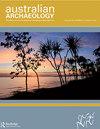The integrated cultural landscape of North Gidley Island: Coastal, intertidal and nearshore archaeology in Murujuga (Dampier Archipelago), Western Australia
IF 1.2
3区 历史学
Q2 ANTHROPOLOGY
引用次数: 4
Abstract
Abstract Recent studies conducted in Murujuga Sea Country have confirmed that Indigenous Australian archaeology does not end at the modern shore. Since the earliest peopling of the Australian continent, sea levels have fluctuated significantly, dropping as much as 130 m below modern mean sea-level during the Last Glacial Maximum (LGM). During this period, the continent (including Australia and New Guinea) represented a landmass one-third larger than present day Australia. As sea levels rose following the LGM, this extensive cultural landscape was inundated. The recent reporting of archaeological remains in a submerged context at Murujuga has enabled an integrated analysis of the archaeological landscape, based on direct evidence from archaeological sites that were originally formed on dry land, but are now located in intertidal and submerged environments. This study applies a landscape analysis centred on the submerged Cape Bruguieres channel site, and the Gidley Islands, where submerged, intertidal and coastal archaeology has been recorded. Aerial, pedestrian, and intertidal archaeological surveys were conducted to investigate the onshore and offshore landscape, providing new evidence with which to place the stone artefacts in the Cape Bruguieres channel into a wider context. Rock art engravings, grinding patches, quarries and upstanding stones – some of which are in the intertidal zone – point to the use of a landscape that is now submerged and to the possibility of discovering new underwater sites. By integrating evidence from subtidal and intertidal contexts with the onshore record, we explore the cultural landscape above and below the ‘waterline’ as a continuum.北吉德利岛的综合文化景观:西澳大利亚Murujuga(丹皮尔群岛)的海岸、潮间带和近岸考古
最近在Murujuga海国进行的研究证实,澳大利亚土著考古并没有在现代海岸结束。自澳大利亚大陆最早出现人类以来,海平面大幅波动,在末次盛冰期(LGM)期间,海平面比现代平均海平面低130米。在这一时期,这块大陆(包括澳大利亚和新几内亚)的面积比现在的澳大利亚大三分之一。随着海平面的上升,这片广阔的文化景观被淹没了。最近在穆卢杰加水下环境中发现的考古遗迹的报告,使人们能够根据最初形成于陆地上的考古遗址的直接证据,对考古景观进行综合分析,但现在位于潮间带和水下环境中。本研究以水下的Bruguieres角海峡遗址和Gidley群岛为中心进行景观分析,在这些岛屿上有水下、潮间带和海岸考古的记录。进行了空中、行人和潮间带考古调查,以调查陆上和海上景观,为在更广泛的背景下放置Bruguieres角通道中的石头人工制品提供了新的证据。岩石艺术雕刻、磨块、采石场和直立的石头——其中一些位于潮间带——表明了对现在被淹没的景观的利用,以及发现新的水下遗址的可能性。通过将潮下和潮间带背景的证据与陆上记录相结合,我们将“水线”上下的文化景观作为一个连续体进行探索。
本文章由计算机程序翻译,如有差异,请以英文原文为准。
求助全文
约1分钟内获得全文
求助全文

 求助内容:
求助内容: 应助结果提醒方式:
应助结果提醒方式:


